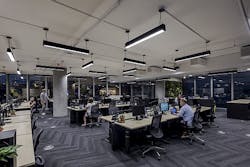Delos reveals new headquarters with LED lighting meeting WELL and other certifications
Ketra LED luminaires deliver what the company calls Natural Light in the Delos facility via time-of-day-based programmable control and tunable spectrum.
Delos, which refers to itself as a “wellness real estate and technology firm,” has announced the opening of a new corporate headquarters facility that features WELL Certification and that will likely receive LEED recognition as well. The tunable solid-state lighting (SSL) is a key element of the WELL recognition with the LED-based system from Ketra delivering what Ketra calls Natural Light. The Ketra technology was also the basis of a residential LED lighting project that we covered firsthand last year.
Delos was formed a decade ago focused on how indoor spaces could be optimized for human health and comfort. Back in 2014, the company was the driving force in launching the WELL Building Standard working in collaboration with the Mayo Clinic and others. Subsequently, Delos created the independent International WELL Building Institute (IWBI) to promulgate the concepts and manage the process of companies having their facilities WELL certified.
Lighting is one key element of meeting WELL requirements. We covered in detail the process of a New York office going through the lighting design and WELL certification processes some two years ago. Indeed, our coverage included the perspective of a lighting manufacturer. And a second article chronicled the perspective of the lighting designers working on the project.
In terms of the lighting angle, WELL principles follow along the concepts of human-centric lighting or lighting for health and wellbeing. Spectral power distribution (SPD) of the lighting is adapted during the day to match the circadian cycle and the activity workers face. More blue spectral energy is present early in the day and more red energy later in the day and at night. Moreover, natural daylight is recognized as an important element of a WELL Building.
LED luminaires by Ketra utilize tunable technology to produce what the company calls Natural Light at Delos headquarters, where human-centric lighting principles covered in the WELL Building standard are being put into practice. (Photo credit: Delos.)
For its new headquarters, Delos wanted to embrace the principles its research has established. The organization wanted to create a showcase for the company’s values and provide every employee an adaptable and pleasant workspace. Natural daylight was established as important throughout, and the company entered the process intending to win WELL Platinum and LEED Platinum recognition.
The Delos team worked with lighting designer Caitlin Toczko of Atelier Ten. After evaluating SSL products and control systems from a number of vendors, the team chose Ketra as the supplier. The Ketra system was determined to meet the needs of varying SPD to provide employees ideal light while also meeting LEED requirements for energy efficiency. It’s worth noting that some tunable products use more energy than fixed-SPD products because more LED channels are in use, with many working at a fraction of max output and well below optimum energy-efficiency levels. You can watch a video on the Ketra website that details the dynamic lighting features.
The project began with the choice of the space but ultimately depended on the SSL technology to deliver on the promise. “We chose a space that would allow us to have a lot of natural daylight,” said Janna Wandzilak, director of Delos solutions. “It’s amazing to have a dynamic lighting system to match. Ketra is also really helpful in spaces with deep floor plates where desks and rooms occupying the deepest parts have no access to natural light.”
The Delos project was implemented and certified based on WELL Version 1. But the WELL Building Institute is already well into the process of creating WELL Version 2. We covered formation of a Light Concept Advisory to guide the process relative to lighting last summer.

Maury Wright | Editor in Chief
Maury Wright is an electronics engineer turned technology journalist, who has focused specifically on the LED & Lighting industry for the past decade. Wright first wrote for LEDs Magazine as a contractor in 2010, and took over as Editor-in-Chief in 2012. He has broad experience in technology areas ranging from microprocessors to digital media to wireless networks that he gained over 30 years in the trade press. Wright has experience running global editorial operations, such as during his tenure as worldwide editorial director of EDN Magazine, and has been instrumental in launching publication websites going back to the earliest days of the Internet. Wright has won numerous industry awards, including multiple ASBPE national awards for B2B journalism excellence, and has received finalist recognition for LEDs Magazine in the FOLIO Eddie Awards. He received a BS in electrical engineering from Auburn University.





